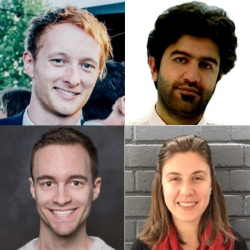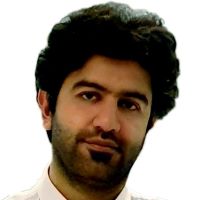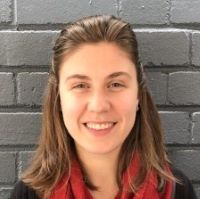Royal Society of NSW News & Events
1290th OGM including Open Lecture
 Royal Society of NSW 2020 Student Award Presentations
Royal Society of NSW 2020 Student Award Presentations
Matthew Donnelly, UNSW (Sydney)
Sajad Razavi Bazaz, UTS
Daniel Fox, ANU
Philippa Specker, UNSW (Sydney)
Date: Wednesday, 3 February 2021, 6.30pm AEDT
Venue: Zoom Webinar.
Video presentation: YouTube video
The evening’s program comprises four short talks presented by PhD Candidates who have been awarded the Society's Jak Kelly Award and the Royal Society of NSW Scholarships for 2020. Follow the links to read a summary of each presentation and a brief biography of the presenter.
Mr Matthew Donnelly (Jak Kelly Award) — Controlling how electrons move in silicon at the atomic scale
Mr Sajad Razavi Bazaz (Scholarship Winner) — 3D printed micro-engineered systems for life science research
Mr Daniel Fox (Scholarship Winner) — Molecular Mechanisms of Inflammasome Activation by Enterotoxins of the Foodborne Pathogen Bacillus cereus
Ms Philippa Specker (Scholarship Winner) — Improving the treatment of Posttraumatic Stress Disorder in refugees: The important role of emotion regulation
Presentation Summaries and Brief Biographies of the Presenters
 Controlling how electrons move in silicon at the atomic scale
Controlling how electrons move in silicon at the atomic scale
Mr Matthew Donnelly, PhD Student, UNSW (Sydney)
Silicon is one the most important materials in the modern world due to its use in the integrated circuits that make up the computers and phones we use every day. We use silicon to build computers because it is a semiconductor — a class of materials in which we can control how electrons move at the micro and nano scale.
Mr Donnelly’s work focusses on manipulating silicon at the ultimate limit — a single atom — and how we can use this control to fabricate quantum computers, machines that promise to solve a new generation of computational problems. In particular, he will demonstrate how controlling a phenomenon known as quantum tunnelling is critical in this process, and how novel fabrication techniques are bringing these machines one step closer to reality.
Matthew Donnelly is a PhD candidate in the group of Prof. Michelle Simmons within the ARC Centre of Excellence for Quantum Computation at UNSW (Sydney). His research investigates monolithic donor structures in silicon and their application in spin-based quantum computing. In particular, he is focussed on using 3D fabrication techniques to precisely control tunnel rates and other parameters critical to the operation of spin qubits.
 3D printed micro-engineered systems for life science research
3D printed micro-engineered systems for life science research
Mr Sajad Razavi Bazaz, PhD Student, University of Technology Sydney
Scaling down high-cost and demanding facilities into tiny, multi-functionalised microchips has revolutionised research areas — a technology referred to as microfluidics. Microfluidics is a science that allows the manipulation of minuscule fluid samples, ordinarily in the range of microliters, within networks of channels ranging from tens to hundreds of micrometers. Microfluidic systems are promising tools for the advancement of chemical and biological research with evident benefits. Improvements such as reduced reagent consumption, higher sensitivity, modelling of in vivo microenvironments, rapid processing, detailed spatial resolution, process integration, and automation have been achieved over the past three decades.
In recent years, additive manufacturing, particularly 3D printing, has gained significant traction, being named the third industrial revolution. Due to the expanding use of microfluidic systems in laboratories, 3D printing has emerged as an alternative method to the traditional, costly fabrication process. The ability to fabricate structures ranging from a few microns to several centimeters is a complex process that can only be accomplished by taking advantage of 3D printing methods. Rapid prototyping provides an opportunity to adopt a “fail fast and often” strategy, motivating the researchers to utilise 3D printers in the field of microfluidics. In this fabrication method, a physical object is fabricated from a virtual model by designing the object via computer-assisted design (CAD) software, converting the design into the 3D printer language, and printing with a 3D printer in a single process.
The modularisation of microfluidic devices using additive manufacturing enables researchers to fabricate integrated microfluidic devices for various applications. Among all these different applications, research in life science technologies has shown significant promise. Not long ago, microfluidics was a burgeoning technology on the fringe of practical applications; now, it is coming of age in the life sciences and being recognised its enormous potential. This presentation will showcase the use of 3D printed micro-engineered systems in research in the life sciences.
Sajad Razavi Bazaz is a PhD candidate in the a School of Biomedical Engineering of the University of Technology Sydney. His main research focus is to develop functional 3D-printed micro-engineered microfluidic devices for life science research. During his PhD journey, he has been able to develop a new functional 3D printing method for the fabrication of microfluidic devices. Toward his goals, Sajad and his colleagues have established a start-up company to develop 3D printed microfluidic devices for selective sperm selection in the IVF market.
 Molecular mechanisms of inflammasome activation by enterotoxins of the foodborne pathogen Bacillus cereus
Molecular mechanisms of inflammasome activation by enterotoxins of the foodborne pathogen Bacillus cereus
Mr Daniel Fox, PhD Student, Australian National University
Bacillus cereus is a clinically important and neglected human foodborne pathogen. This Gram-positive and rod-shaped bacterium is found ubiquitously in the environment and in undercooked and processed food products. Ingestion of B. cereus endospores often leads to germination and propagation of viable vegetative cells in the human gastrointestinal tract, which can lead to emetic and diarrheal syndromes largely depending on the production of enterotoxins. Of concern is the potential for B. cereus to cause often-fatal extra-gastrointestinal disease in immune-compromised patients, including systemic bacterial septicemia, ocular infections, anthrax-like pneumonia, cutaneous gas-gangrene-like infections, and infections of the central nervous system.
B. cereus secretes multiple toxins, including the tripartite toxins haemolysin BL (HBL) and non-haemolytic enterotoxin (NHE). Our lab has previously made the important observation that HBL induces activation of the cytosolic inflammasome sensor NLRP3, which subsequently promotes the production of inflammation and host cell death. However, of particular interest is that B. cereus isolates which lack HBL can cause inflammation and disease in humans, suggesting that other non-redundant virulence factors are critical in the pathogenesis of this pathogen. My work has identified that NHE of B. cereus is also able to induce activation of the NLRP3 inflammasome and cell death via a mechanism targeting the plasma membrane of host cells. I found that the subunits of this toxin assemble to form a functional pore, which drive the efflux of cytosolic potassium from the host cell. This toxin kills cell types from multiple lineages and host origin, highlighting its functional repertoire in different host species. Moreover, my findings suggest that both NHE and HBL operate synergistically to induce inflammation in the host. Overall, my results highlight that multiple virulence factors from the same pathogen exhibiting conserved function and mechanism of action can be exploited for sensing by a single inflammasome, ultimately leading to increased capacity of the host to detect and defend against naturally-occurring genetic variants.
Daniel Fox first started his research career as an undergraduate summer research student in the laboratory of Prof. Si Ming Man, in late 2017. Daniel went on to pursue and complete a first-class Honours degree in Medical Science in Prof. Man’s lab in 2018, where he published work in the Journal of Molecular Biology and Nature Microbiology, both as a co-first, and co-author. He began his PhD in 2019, continuing in Prof. Man’s lab, where he continued to characterise the innate immune response to clinically important, and neglected human foodborne pathogens. Since starting his PhD, Daniel has been selected to present his work at conferences both in China and the USA, has published first-author work in Nature Communications, and Cell Research, and has won two grants from the Gretel and Gordon Bootes Medical Research Foundation, totalling $23,500 AUD. He hopes to continue to advance his work in innate immunity as a medical researcher in the future.
 Improving the treatment of Posttraumatic Stress Disorder in refugees: The important role of emotion regulation
Improving the treatment of Posttraumatic Stress Disorder in refugees: The important role of emotion regulation
Ms Philippa Specker, PhD Student, UNSW (Sydney)
The psychological presentation of traumatised refugees is complex and presents a global challenge to public health. There are currently an estimated 80 million refugees, asylum seekers, and internally displaced people worldwide and this number is steadily growing. Refugees encounter multiple and severe forms of trauma, such as war exposure, torture, imprisonment, and witnessing the murder of loved ones. Then, after fleeing danger, refugees also experience ongoing stress due to family separation, visa insecurity and socio-economic difficulties. Owing to these experiences of persecution and displacement, refugees experience greatly elevated rates of psychological disorders. In particular, as many as 1 in 3 refugees suffer from Post-traumatic Stress Disorder, or PTSD. Although psychological treatments for PTSD exist, they were not designed to address the psychological complexities of refugee experiences. In particular, many refugees have difficulties managing intense and unresolved emotions including fear, grief, anger, disgust, sadness, and guilt. While emotion regulation difficulties have been linked to psychopathology among other populations, very little research has investigated whether emotion regulation difficulties may be implicated in the development of mental illness among refugees. Such research may be crucial in facilitating the improvement of psychological treatment for refugees.
This talk will discuss emerging research on the role of emotion regulation in the development and maintenance of PTSD among refugees. pa will discuss findings from her PhD research, including quantitative and experimental studies with refugees, to highlight how emotion regulation skills training may aid in the resolution of PTSD symptoms.
Philippa Specker is a PhD candidate enrolled in the combined PhD/Master of Psychology (Clinical) Program at UNSW. pa’s research is in the area of emotion regulation and refugee mental health, and seeks to understand how exposure to traumatic events impact on an individual’s capacity to utilize emotion regulation strategies to manage psychological distress. Her research aims to advance knowledge regarding mechanisms underpinning trauma-related psychopathology, and inform the development of effective and tailored interventions for survivors of persecution and displacement. Philippa has published three peer-reviewed papers in leading journals including the European Journal of Psychotraumatology and Clinical Psychology Review, and has presented her research at three national and five international conferences. In recognition of her contribution to the field of traumatic stress through research, clinical work and community advocacy, Philippa received the International Society for Traumatic Stress Studies’ Outstanding Student Achievement Award (2020) and was shortlisted for the Australian-American Postgraduate Fulbright Award (2020). Philippa is also a Clinical Psychology Registrar at the Refugee Trauma and Recovery Program, where she delivers evidence-based treatment for refugees suffering from PTSD.

